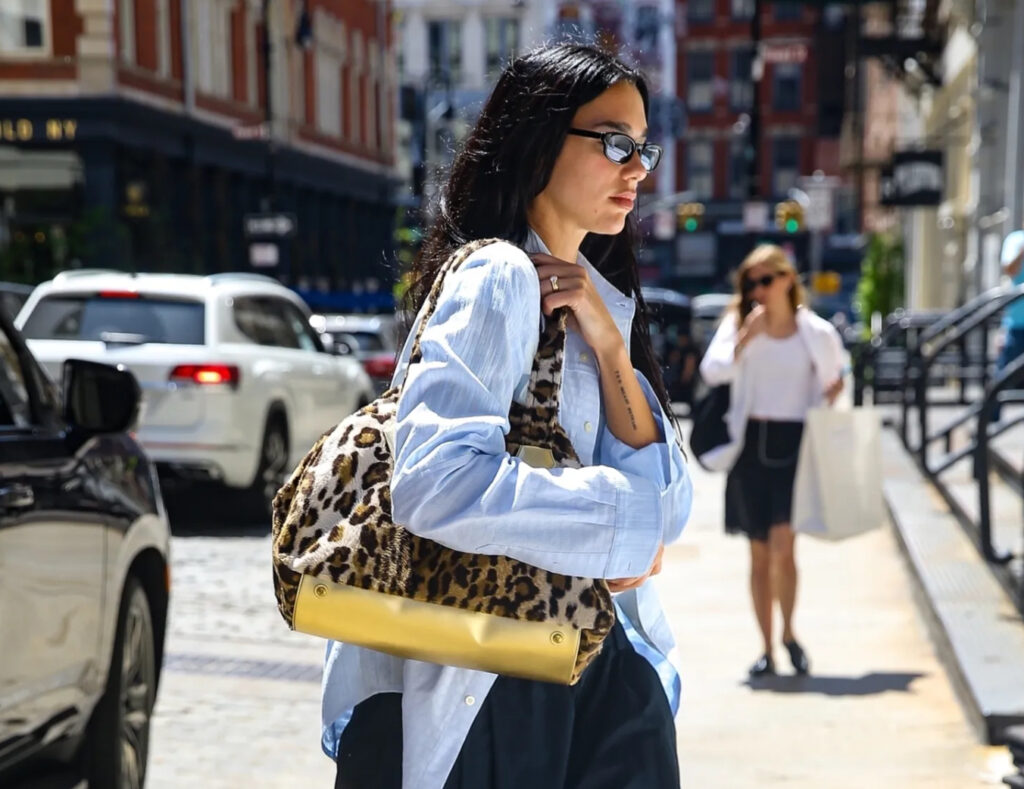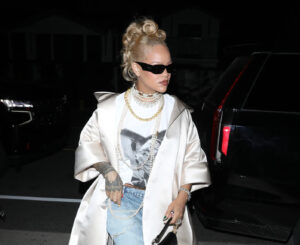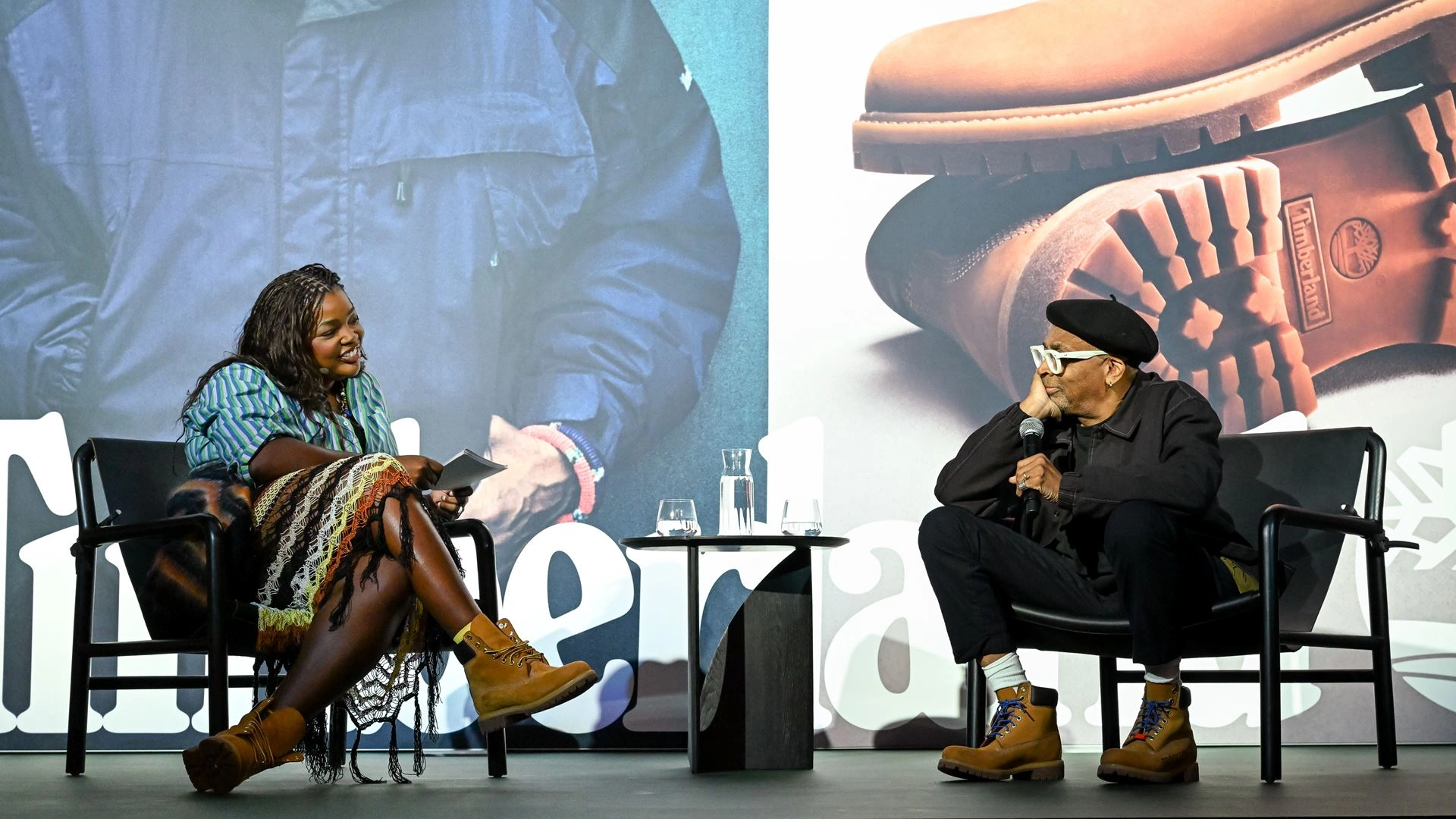
In an industry where the cadence of personal branding is as crucial as vocal prowess or chart-topping success, it’s no longer enough for pop stars to sing — they must signify. Few do this with more sartorial fluency than Rihanna and Dua Lipa, two icons separated by era but bound by an uncanny stylistic telepathy. Though the global timeline of their fame differs, their aesthetic vectors now intersect more frequently than coincidence would suggest.
A subtle convergence is underway — not in headlines or paparazzi shots alone, but in the granular choices of denim, bags, and especially, shoes. The Bottega Veneta Kalimero Bucket Bag and Celine jeans have become unofficial emblems of this closet overlap. And while garments may be the stage, footwear is the act. In their case, the repeated cameo of Puma sneakers — from archival Speedcats to limited drops engineered under A$AP Rocky’s creative direction — becomes a cultural cipher. More than shared preferences, these mirrored choices suggest a fashion ecosystem tightly woven by a singular force: stylist Jahleel Weaver.
Jahleel Weaver: The Architect of Pop’s Fashion Parallels
As Rihanna’s longtime fashion consigliere and a seasoned deputy creative director at Fenty, Jahleel Weaver possesses the rare ability to transcend star power and build universes. His styling does not merely dress — it directs. And lately, that direction has taken Dua Lipa through a wardrobe that echoes Rihanna’s greatest fashion hits.
Weaver’s role in aligning their sartorial orbits is not accidental. It’s strategic — leveraging the cross-generational appeal of Rihanna, who redefined maternity wear and elevated streetwear to red carpet viability, and positioning Lipa as a vanguard of the same energy. If Rihanna walked so future pop icons could wear leopard fur doctor bags with business casual basics, then Lipa is now sprinting.
This stylistic baton pass, however, is not mimicry. It’s evolution. Weaver’s vision for Lipa retains her own fashion syntax — younger, sleeker, a touch more European. But the DNA is unmistakable. Take, for instance, Lipa’s April 29 outing in New York: a pale blue button-down, pleated navy trousers, Chrome Hearts shades, and the kicker — mesh Gucci slingback heels, a pair that Rihanna herself had championed months prior.
The Shoe as Semantics: From Puma to Gucci
In celebrity fashion, shoes function as more than accessories — they are declarations. And for both Lipa and Rihanna, the message is loud, luxurious, and layered with semiotic richness. Puma, once a background player in the sneaker wars, owes a significant portion of its cultural capital to Rihanna’s Fenty imprint. That Lipa now sports A$AP Rocky’s Speedcats in a carousel of colors reaffirms Puma’s relevance and subtly reanimates Rihanna’s legacy through a new body.
But the more recent pivot to Gucci — specifically, the mesh slingback heels — marks a tonal shift. These shoes, balancing erotic transparency with corporate geometry, serve as the latest manifestation of the “corporate sleaze” aesthetic permeating fashion. Lipa’s pairing of these heels with her otherwise utilitarian ensemble transforms the look into something linguistically sly: business from the waist up, provocation at ground level.
The juxtaposition of utilitarian structure and feline flair in Lipa’s look is pure Rihanna grammar, delivered through Lipa’s accent. Leopard fur, Chrome Hearts, pleated pants — each piece defies singular classification. This is style as language, spoken fluently across two bodies.
Corporate Sleaze and Pop-Feminine Irony
This aesthetic—coined by trend theorists as “corporate sleaze”—is not merely about mismatching styles. It’s a deliberate queering of office codes: classic shirting paired with shoes you wouldn’t wear to HR. It is irony dialed up to subversion. By embracing this look, Lipa and Rihanna rewrite the rules for what it means to dress like a pop star in 2025.
What once may have registered as dissonance—sensible trousers with showy heels—is now a kind of armor. For women who live in the limelight, where the line between admiration and scrutiny is razor-thin, corporate sleaze provides a veneer of professionalism with just enough playfulness to remain unpredictable. Lipa’s April look, with its quiet blouse and aggressive accessories, could read as conservative. But those Gucci mesh slingbacks scream otherwise.
Rihanna mastered this dialect years ago. Whether arriving at Fenty launches in oversized Balenciaga blazers with stiletto sandals or pairing graphic tees with Manolo Blahniks, her presence always felt like it had emerged from a futuristic HR training video curated by Grace Jones. Lipa is merely reading from the same gospel now, remixing Rihanna’s irreverence into her own playful irreverence.
Footwear as a Marker of Era and Energy
Footwear trends have always served as a timestamp in fashion’s timeline. The Nike Dunk renaissance marked the early 2020s, while platform boots defined the post-pandemic resurgence of maximalism. In 2025, we’re somewhere between nostalgia and futurism—and slingbacks, mesh finishes, and racing silhouettes like the Speedcat are gaining traction again.
Speedcats, originally developed as motorsport shoes, are oddly suited to today’s fashion climate. Their narrow, aerodynamic shape aligns perfectly with the ballet flat revival and the larger Y2K redux. That Lipa and Rihanna, both known for their heavy-hitting silhouettes, are reaching for these low-profile sneakers suggests a cultural pivot: toward movement, toward function, but never at the expense of flair.
Likewise, the mesh Gucci heels, with their transparency and elastic structure, signify a broader moment in footwear — one where intimacy and architecture coexist. These aren’t simply sexy shoes. They’re conceptual ones. And for two global icons accustomed to being both idolized and dissected, they offer a kind of visible invisibility.
The Shared Closet as a Cultural Mirror
The notion that Rihanna and Dua Lipa “share a closet” is more than just fashion gossip. It’s an allegory for how celebrity style now operates: less as a singular voice and more as a conversation among curated identities. Stylists like Weaver don’t just pull looks — they plot narratives.
And in this case, the narrative arcs elegantly. Rihanna, once the emblem of audacious cool, is now the oracle. Lipa, ascendant and fashion-forward, doesn’t mimic — she metabolizes. Each look she wears with echoes of Rihanna is less imitation and more invocation. It’s Rihanna as blueprint, Lipa as remix.
This doesn’t dilute Lipa’s identity; it enriches it. Just as Rihanna once echoed Grace Jones and Janet Jackson before her, Dua Lipa is part of a continuum where homage becomes evolution. That their shared love for shoes — whether Puma’s relics or Gucci’s future-forward mesh — feels so natural, speaks to the porous nature of modern style: adaptable, referential, and defiantly personal.
Flow
As the paparazzi snaps accumulate and the TikToks dissect every accessory, it becomes clear: what Dua Lipa wears is not arbitrary. It’s authored. It’s part of a longer conversation about fashion’s role in female autonomy, cultural succession, and pop performance.
Footwear, often the most silent part of a look, becomes the loudest indicator of change and inheritance. In Lipa’s Gucci heels and Puma Speedcats, we see Rihanna’s legacy not being mimicked but recontextualized.
There’s a wordless respect between these women, mediated by a stylist who understands the symbiosis of culture, celebrity, and commodity. And in an age of endless content and aesthetic fatigue, it’s refreshing to see a narrative told not in tweets, but in shoes.
After all, style — like music — is rarely about the original note. It’s about the way it reverberates through new voices.
No comments yet.









